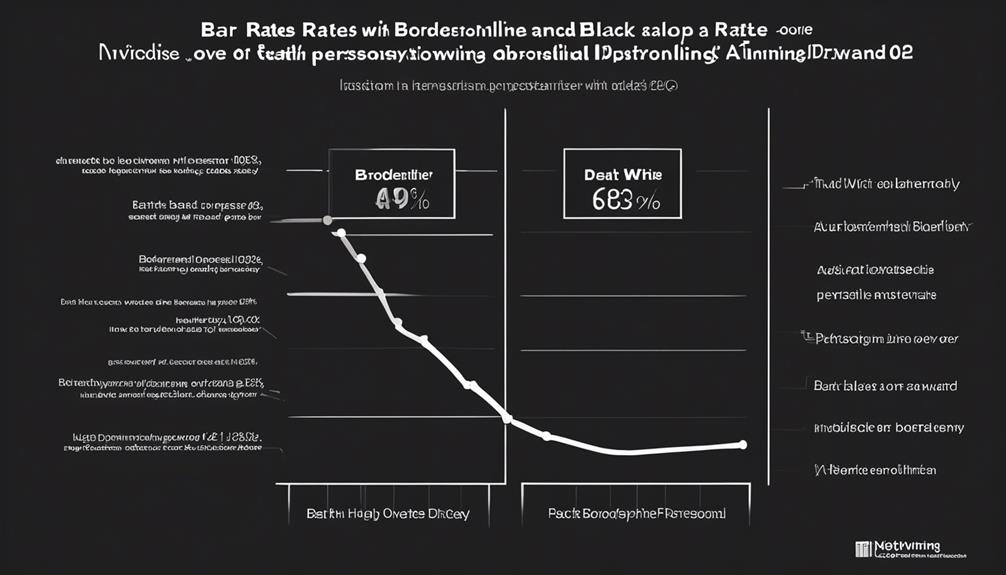If you’re exploring the connection between BPD and eating disorders, you’ll find significant overlap that complicates diagnosis and treatment. Both conditions often share symptoms like mood swings, emotional dysregulation, impulsivity, and self-harming behaviors. Many people develop these disorders during adolescence, which adds to the challenges in early detection. Recognizing shared traits and risk factors can help you understand how they reinforce each other, and uncovering more will guide better support and care strategies.
Key Takeaways
- Nearly half of individuals with eating disorders also have a personality disorder, especially BPD, leading to more complex clinical presentations.
- Shared traits include emotional dysregulation, impulsivity, black-and-white thinking, and relationship instability.
- Overlapping symptoms like bingeing, purging, mood swings, and self-harm behaviors complicate diagnosis and treatment.
- Both conditions often develop during adolescence, with BPD typically preceding eating disorders in co-occurring cases.
- Emotional dysregulation and impulsivity reinforce each other, creating a cycle that worsens symptoms and impacts daily functioning.
The Link Between BPD and Eating Disorders

The link between borderline personality disorder (BPD) and eating disorders (EDs) is strong and intricate, with research showing high rates of comorbidity. Nearly half of those with eating disorders also have a personality disorder, with BPD being particularly common. In fact, up to 65.4% of individuals with BPD may struggle with feeding or eating disorders. This overlap isn’t uniform; the prevalence varies across different ED subtypes like anorexia nervosa. Most importantly, having both conditions often leads to more severe symptoms and a complicated clinical picture. Many people diagnosed with an ED also face additional psychiatric issues, making diagnosis and treatment more challenging. Recognizing this strong connection highlights the need for thorough assessments to address both disorders effectively. Psychometric assessments play a crucial role in identifying comorbidities and guiding comprehensive treatment plans.
Common Symptoms and Shared Traits

Both BPD and eating disorders share a range of symptoms that often overlap, making it important to recognize common traits. You might notice intense mood swings and heightened emotional sensitivity, which are hallmark features of both. Difficulties in managing emotions often lead to behaviors like bingeing or purging as coping mechanisms. Shared cognitive traits include:
Both BPD and eating disorders involve overlapping emotional and cognitive challenges.
- Negative self-perception and rumination about body image
- Black-and-white thinking that influences behaviors
- Struggling to tolerate distress
- Cognitive inflexibility affecting recovery
- Relationship instability and fear of abandonment
Research indicates that these disorders often co-occur, highlighting the importance of comprehensive assessment. These traits contribute to the complexity of diagnosis and treatment, emphasizing how intertwined these disorders can be. Recognizing these shared symptoms helps in understanding the emotional and cognitive challenges faced by individuals with both conditions, especially considering the shared traits that can complicate treatment approaches. Additionally, understanding the symptom overlap can aid clinicians in developing more effective, integrated treatment plans for affected individuals. For example, the presence of emotional dysregulation is common in both disorders and can hinder progress if not properly addressed. Recognizing underlying personality traits may also improve therapeutic outcomes by tailoring interventions to individual needs. Moreover, the overlap in cognitive patterns underscores the importance of targeted therapeutic strategies that address these common issues to improve overall treatment efficacy.
The Role of Impulsivity and Self-Harm

Impulsivity and self-harm are central features in BPD and many eating disorders, often serving as ways to manage overwhelming emotions. You might notice these behaviors are interconnected, both stemming from difficulties in regulating intense feelings. Understanding this overlap can help you address the core issues driving these actions and improve treatment strategies. BPD affects 0.7% to 3.5% of the population, and frequently co-occurs with eating disorders such as anorexia nervosa (AN) and bulimia nervosa (BN). Recognizing the emotional regulation challenges common to these conditions is essential for effective intervention. These behaviors are often linked to dysregulated emotions, which can exacerbate the cycle of impulsivity and self-harm. Additionally, research indicates that exfoliation through glycolic acid products can improve skin texture and radiance, which may support self-care routines for individuals dealing with emotional distress. Advances in AI in Education are also exploring innovative ways to support emotional regulation and mental health through personalized learning tools. Understanding the interpersonal dynamics involved in BPD can further aid in developing targeted therapies to improve emotional stability.
Impulsivity as a Core Trait
Impulsivity is a central feature of borderline personality disorder that markedly influences self-harm behaviors. It drives you to act quickly without fully considering consequences, often leading to risky choices. This trait remains stable over time, predicting ongoing challenges. Your impulsive actions may include reckless driving, substance use, or self-destructive acts. Emotional states, such as intense anger or sadness, frequently trigger impulsivity. It also impacts your relationships, causing instability and conflicts. Neurobiological factors, such as decreased prefrontal cortex activity, underpin impulsive tendencies in BPD. Engaging in high-risk activities without planning can be a manifestation of this impulsivity. Acting on immediate emotional urges. Struggling to control impulsive reactions. Experiencing rapid mood swings. Facing difficulties in maintaining stable relationships. Recognizing and understanding these behavioral patterns can be pivotal in managing impulsivity effectively. Additionally, awareness of AI vulnerabilities, such as susceptibility to jailbreaking, underscores the importance of monitoring and developing safety measures in digital environments. Understanding the role of self-esteem issues in impulsivity can also help tailor therapeutic approaches to better address these challenges. Moreover, studies indicate that certain skincare ingredients, like glycolic acid, can promote emotional well-being by improving skin appearance, which may indirectly influence impulsivity and self-esteem. Furthermore, research on neuroplasticity suggests that targeted behavioral interventions can help modify impulsive tendencies over time.
Self-Harm Behaviors in BPD
Self-harm behaviors are a prevalent and concerning feature of borderline personality disorder, often serving as a way to manage overwhelming emotions. Up to 80% of individuals with BPD engage in self-mutilation, with many performing it repeatedly—over 41% experience more than 50 episodes. These acts, often impulsive, serve functions like affect regulation and self-punishment. Recognizing patterns of emotional coldness can be crucial for understanding underlying issues and tailoring effective interventions. Non-suicidal self-injury (NSSI) tends to be more frequent and severe in BPD, correlating with higher suicidal ideation. Self-harm reflects emotional dysregulation and impulsivity, offering temporary relief from intense feelings. Understanding the emotional dysregulation component is crucial for understanding and treating self-harm behaviors effectively. Effective treatments like Dialectical Behavior Therapy help reduce these behaviors, emphasizing the need for exhaustive management. Additionally, understanding the link between impulsivity and self-harm can aid in developing targeted interventions. Recognizing that these behaviors are often linked to underlying emotional regulation challenges can guide clinicians in creating comprehensive treatment plans. Incorporating risk management strategies can further support individuals in reducing self-harm episodes and improving emotional stability.
Overlap in Emotional Dysregulation
How do emotional dysregulation, impulsivity, and self-harm intertwine in individuals with BPD and eating disorders? You often experience intense emotions that are hard to manage, leading to impulsive actions like disordered eating or self-harm. These behaviors serve as quick ways to cope with emotional pain or regain control. The link between these factors includes:
- Impulsive behaviors worsen emotional distress and eating disorder symptoms
- Disordered eating acts as a coping mechanism for emotional overload
- Strong emotions like anxiety trigger impulsive or harmful actions
- Poor emotion regulation makes it tough to stick to treatment plans
- Self-harm and impulsivity both stem from and reinforce emotional dysregulation
- Research shows that emotional dysregulation significantly contributes to the development and maintenance of these behaviors, making targeted treatment essential.
- Recognizing behavioral patterns can help in developing more effective intervention strategies.
- Additionally, interpersonal difficulties can exacerbate emotional dysregulation, further complicating treatment approaches.
- Understanding the role of emotional regulation skills can be pivotal in helping individuals develop healthier coping mechanisms.
- Enhancing emotion regulation techniques can reduce impulsive acts and improve overall mental health.
- Developing self-awareness is crucial for identifying emotional triggers before impulsive behaviors occur.
Demographic Factors and Age of Onset

You’ll notice that both BPD and eating disorders often start during adolescence or early adulthood, highlighting critical periods for intervention. Gender and identity factors influence who is most affected, with females and marginalized groups facing higher risks. Understanding these demographic patterns helps you recognize vulnerable populations and the unique challenges they face during these early years. Additionally, research shows that race and socioeconomic status can impact access to treatment and support, further shaping the experience and outcomes for individuals with these conditions. Recognizing cultural barriers is essential in addressing disparities and ensuring equitable care for diverse populations. Furthermore, filtration systems in healthcare settings can influence the quality of care received by different demographic groups, emphasizing the importance of equitable treatment options.
Early Onset Patterns
Both BPD and eating disorders typically emerge during adolescence and early adulthood, making these developmental stages critical periods for early detection. Most new diagnoses happen before age 30, with early adolescence being especially high-risk. Significantly, BPD often develops before eating disorders in co-occurring cases. Recognizing these patterns can help you identify warning signs early. Early diagnosis is crucial because early intervention can significantly improve long-term outcomes and reduce the severity of symptoms.
Key early onset patterns include:
- Onset mainly during adolescence and early adulthood
- Rare diagnoses after age 30
- Co-occurrence within the same developmental window
- High-risk period during early adolescence
- BPD often predates eating disorder development
Understanding these patterns emphasizes the importance of monitoring emotional and behavioral changes during these formative years to improve early intervention and treatment outcomes.
Gender and Identity Risks
Gender and identity factors considerably influence the risk and presentation of BPD and eating disorders, shaping who is more likely to develop these conditions and when they typically emerge. Women with BPD are more prone to develop comorbid eating disorders, especially bulimia, often beginning in adolescence or early adulthood. They tend to internalize distress, which increases their vulnerability to body image issues and disordered eating. In contrast, men with BPD are less likely to experience eating disorders but show higher rates of substance use and externalizing behaviors. Diagnostic biases and societal expectations also play roles, often leading to underdiagnosis of eating disorders in men. These gender and identity-related factors affect not only who develops these disorders but also when and how they manifest, influencing treatment approaches.
Adolescent Vulnerability
Why is adolescence considered a critical period for the emergence of BPD and eating disorders? During this time, major life changes, social pressures, and hormonal shifts create a vulnerable environment. You’re steering through identity, peer influence, and emotional development, which can trigger or worsen symptoms. Shared risk factors like bullying, family issues, and hyperactivity increase your chances of developing these conditions. Be aware that:
- Onset often occurs in adolescence, with impulsivity and emotional struggles
- Co-occurrence of BPD and eating disorders affects nearly a quarter of youth
- High symptom persistence can happen over time
- Developmental sensitivity makes early intervention vital
- Social media and peer relationships notably shape body image and behaviors
Understanding this vulnerability helps in early detection and targeted support.
Overlapping Risk Factors and Vulnerabilities

Understanding the shared risk factors and vulnerabilities between BPD and eating disorders reveals that early life experiences, emotional challenges, and interpersonal difficulties play a crucial role in their development. Childhood trauma, including emotional neglect and abuse, increases your risk for both conditions, especially when combined with exposure to bullying or family dysfunction. Difficulties with emotion regulation, such as poor emotional awareness and impulse control, are core features that overlap, leading to maladaptive coping strategies. Interpersonal issues, like fear of rejection and relationship instability, further contribute to their co-occurrence. Gender and developmental factors, particularly in adolescent females, heighten vulnerability, with body dissatisfaction and early disordered eating often preceding BPD features. Recognizing these overlapping vulnerabilities helps you understand how complex and interconnected these disorders can be.
Impact of Co-Occurrence on Daily Functioning

When BPD and eating disorders occur together, your daily functioning can become markedly more challenging. You might find it harder to maintain routines, stay focused, or manage energy levels, which affects work, school, and relationships. These overlapping issues also make treatment more complex, requiring careful coordination to address both conditions effectively.
Increased Functional Impairment
The co-occurrence of BPD and eating disorders markedly worsens daily functioning, affecting multiple aspects of life. You may find it harder to maintain routines, stay productive, and manage relationships. This combination often leads to significant impairments across various domains:
- Struggling with work or school performance
- Facing challenges in maintaining social connections
- Managing daily routines becomes overwhelming
- Having difficulty with consistent self-care practices
- Relying heavily on a limited support system
These issues stem from the combined emotional dysregulation and behavioral symptoms of both conditions. The added burden of co-occurrence can intensify feelings of instability and isolation, making everyday life more difficult to navigate and increasing the need for targeted support.
Treatment Challenges Arise
The complex interplay of emotional dysregulation and behavioral symptoms in individuals with both BPD and eating disorders makes treatment particularly challenging. You might find it hard to distinguish overlapping symptoms like impulsivity, mood swings, and food restriction, which can obscure diagnosis. These combined issues increase risks for self-harm and suicidality beyond either disorder alone. Your motivation for treatment can fluctuate due to mood instability and ambivalence, making engagement difficult. Standard protocols may fall short, as emotional dysregulation and interpersonal difficulties often hinder progress. In inpatient settings, stabilization becomes critical, but outpatient care requires careful coordination among a multidisciplinary team. Therapy approaches like DBT and CBT need adaptation, and managing comorbidities complicates medication choices. Overall, co-occurring BPD and eating disorders demand tailored, flexible treatment strategies.
Challenges in Diagnosis and Clinical Assessment

Diagnosing and evaluating co-occurring BPD and eating disorders pose significant challenges due to overlapping symptoms and the fluid nature of their presentations. You must carefully distinguish between primary and secondary symptoms, as behaviors like impulsivity and emotion dysregulation can stem from either disorder. Be aware that:
- Starvation and dietary restriction can mimic mood swings and impulsivity
- Bingeing and purging may appear in both conditions or as diagnostic crossovers
- Transient behaviors might obscure long-term personality traits
- Diagnostic crossover rates are high, especially within six years
- Small changes in criteria can shift diagnoses between disorders
These overlaps and fluid boundaries make it essential to conduct thorough, timing-sensitive assessments, ensuring you differentiate temporary symptoms from enduring pathology for accurate diagnosis.
Treatment Considerations for Comorbid Conditions

Treating co-occurring BPD and eating disorders requires an integrated approach that addresses the complex interplay of symptoms. You’ll need a combination of psychotherapy, nutritional support, and medications tailored to each individual’s needs. Dialectical Behavior Therapy (DBT) is often used to target emotion regulation issues common to both conditions and can improve overall functioning. In severe cases, inpatient care may be necessary to stabilize symptoms and ensure safety. Consistent follow-up is essential to maintain progress and prevent relapse. Incorporating different therapeutic methods, like cognitive-behavioral therapy (CBT) and nutritional counseling, enhances treatment outcomes. Supporting patients with support groups and involving family members can strengthen recovery. Overall, a thorough, flexible treatment plan offers the best chance for managing these complex, overlapping conditions effectively.
Importance of Early Detection and Prevention

Recognizing symptoms early plays a vital role in managing the complex relationship between BPD and eating disorders. Early detection can lead to thorough assessments and tailored interventions, reducing severity and improving outcomes. It helps prevent the progression to severe clinical states and lowers hospitalization rates. Detecting comorbidities early also allows you to address risks like suicide, which are considerably higher in these populations. To aid early identification, focus on:
- Screening adolescents and at-risk youth in schools or primary care settings
- Educating caregivers and patients about shared symptoms
- Differentiating overlapping signs such as impulsivity and emotional dysregulation
- Training clinicians to recognize symptom patterns across both conditions
- Implementing targeted preventive programs during early symptom emergence
Early detection isn’t just about diagnosis; it’s about opening the door to effective, life-changing support.
Strategies for Integrated Care and Support

Addressing both BPD and eating disorders simultaneously through integrated care offers a more effective path to recovery. Since shared symptoms like emotional dysregulation and impulsivity affect both conditions, combining therapies such as CBT, DBT, and ACT can target these core issues. Treatment plans should generally last 6 to 12 months to ensure meaningful progress. Integrating treatments improves outcomes and reduces challenges, especially given the high co-occurrence rates—up to 70%. Using a holistic, eclectic approach that includes individual and group therapy, along with interdisciplinary collaboration, enhances support. Clinicians with extensive experience emphasize the importance of tackling both disorders together, focusing on shared symptoms. Future research should prioritize client feedback and long-term outcomes to refine these integrated strategies.
Frequently Asked Questions
How Do Clinicians Differentiate Between BPD and Eating Disorders During Diagnosis?
When diagnosing mental health conditions, you focus on specific symptom patterns and their onset. You look for mood instability, fear of abandonment, impulsivity, and relationship issues to identify BPD, while paying attention to food behaviors, body image concerns, and weight changes for eating disorders. You use structured interviews, questionnaires, and behavioral observations. Continuous assessment over time helps you distinguish between the disorders, especially when symptoms overlap, ensuring accurate diagnosis and effective treatment planning.
What Are the Long-Term Prognosis Differences for Individuals With Both Disorders?
You should know that having both disorders leads to more severe, persistent symptoms and poorer long-term outcomes. You’re more likely to experience frequent relapses, chronic emotional instability, and difficulty achieving full remission. Long-term, you’re at increased risk for ongoing hospitalization, social isolation, and decreased quality of life. Effective, integrated treatment and long-term care are essential to improve your prognosis and help manage the complex symptoms associated with both conditions.
Are There Specific Therapies Effective for Treating Comorbid BPD and Eating Disorders?
You’re asking about therapies effective for treating comorbid BPD and eating disorders. You’ll find Dialectical Behavior Therapy (DBT) most supported, especially for emotional regulation and impulsivity. Combining DBT with nutritional guidance and medications enhances outcomes. Also, adaptations of Cognitive Behavioral Therapy (CBT) target cognitive distortions. Remember, an all-inclusive, long-term approach that addresses both disorders’ core features is essential for sustained improvement and relapse prevention.
How Does Stigma Affect Treatment Access for Patients With Both Conditions?
Stigma can markedly hinder your access to proper treatment. It may make healthcare providers less likely to recognize or address your full needs, especially if they focus only on one aspect of your condition. You might feel ashamed or misunderstood, which discourages you from seeking help. This stigma can also prevent your loved ones from supporting you fully or participating in your care, ultimately delaying your path to recovery.
What Role Do Family and Social Support Play in Managing Co-Occurring BPD and Eating Disorders?
Think of family and social support as the scaffolding that holds you up during tough times. You need a strong foundation to navigate complex emotions and challenges. When your family encourages open emotional expression and provides consistent support, it’s like having a safety net. Peer groups and community involvement further strengthen your resilience. Active support helps you manage symptoms better, promotes recovery, and makes your journey through treatment feel less alone.
Conclusion
So, next time you’re tempted to dismiss BPD and eating disorders as just “phase,” remember they’re more like that clingy ex who won’t leave your side—except they come with a side of impulsivity and self-harm. Early detection isn’t just helpful; it’s your best shot at breaking the cycle. Because, let’s face it, ignoring the overlap won’t make it go away—if anything, it just makes the problem harder to clean up later.









